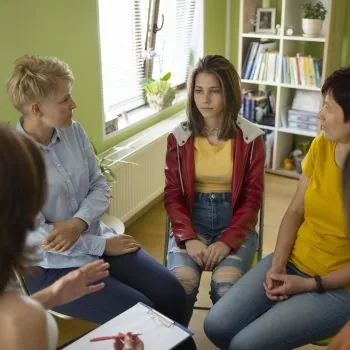This June’s PTSD Awareness Month aims to raise awareness about post-traumatic stress disorder and its effects. Parents can support teens coping with PTSD by creating a safe and understanding environment, encouraging open communication, and seeking professional help when needed. Providing unconditional love and patience while respecting their boundaries can foster healing and resilience in teens affected by trauma.
One study suggests that by age 18, 8% of youth who have experienced trauma have met the criteria for a diagnosis of PTSD, with numbers rising to 40% in cases of sexual abuse and assault (NIH).
This month is recognized as PTSD Awareness Month, dedicated to raising awareness about post-traumatic stress disorder and its impact on individuals, including children and teens.
During this month, various organizations and communities host events and campaigns to educate the public about PTSD symptoms, treatment options, and resources available for support.
This article explores PTSD awareness month and how parents can help teens cope and heal from trauma.
What is PTSD Awareness Month?

PTSD Awareness Month was first established as PTSD Awareness Day on June 27th, 2010, in recognition of Staff Sergeant Joe Biel, who experienced PTSD due to his tours in Iraq and died by suicide in 2007. Four years later, in 2014, the federal government designated the entire month of June as PTSD Awareness Month in recognition of the effects of PTSD on not just the men and women who serve to protect their country but also the countless victims of abuse, war, and natural disasters who survive and experience symptoms of post-traumatic stress.
During PTSD Awareness Month, federal organizations and NGOs try to spread the word on the effects and treatment paths for different forms of PTSD and how PTSD affects people across all walks of life, including young children and teens.
PTSD is often associated with war veterans. Before it was described and classified in the DSM in 1980, the psychiatric world had described post-traumatic stress as “shell shock” and “war neurosis.” We know today that while many in the military struggle with PTSD compared to the general public, those who struggle with symptoms of PTSD the most include survivors of trauma at home, especially traumatic events such as experiencing war as a civilian, sexual abuse, assault, and domestic violence.
Helping Teens Cope with PTSD
Symptoms of PTSD in teens can vary from those of younger children and older adults. Teens with PTSD are more likely to lash out emotionally and experience irritability.
Making sure teens with PTSD get all the help they need starts with learning to recognize the signs and symptoms of post-traumatic stress in adolescents. Family members and educators should watch children who survived a traumatic event and take note of changes or irregularities in their actions and behavior. Here’s how parents can help their teens cope with PTSD:
Professional Therapy
Post-traumatic stress disorder consists of symptoms of re-experiencing or intrusive thinking, avoidance, mood symptoms, and reactivity or hyperarousal (experiencing extreme stress, irritation, or even constant anxiety). While specific symptoms differ from case to case, someone going through PTSD will experience all four of these types of symptoms.
Teens will struggle to focus and concentrate, may have trouble with interpersonal communication or forming healthy relationships, and are more likely to lash out at others.
Professional therapy is needed as part of a comprehensive treatment plan for a PTSD diagnosis. Ensure your teen considers and finds a therapist they can trust and feel comfortable with.
Peer Support Groups
One-on-one therapy is crucial, but support groups can help teens feel less alone while going through an often-isolated treatment experience.
Knowing other teens with similar experiences and struggles can be comforting, especially when they offer to support each other through active listening, group therapy, and other activities.
Family Involvement
Family therapy can be another powerful avenue of support for parents and other relatives. During family therapy sessions, parents learn how to better communicate with their teens, foster more productive conversations to avoid conflict or de-escalate a fight, and help teens work on their social and communicative skills at home.
Physical Activity
Physical activity can help teens with PTSD manage their cognitive (mood) symptoms, as well as potentially help reduce stress and anxiety levels. If your teen doesn’t have a preferred sport or physical activity, then a good way to support them is to help them find something they can consistently do to keep in shape and help cope with negative or intrusive thoughts and feelings.
Residential Treatment
An in-depth treatment plan can be challenging to follow, especially from home. Residential or inpatient treatment gives teens a few weeks to settle into a routine to help manage their symptoms and better juggle their home and academic responsibilities with therapy.
How Parents Can Help Teens Heal
This PTSD Awareness Month is all about spreading the word on the symptoms of PTSD, helping families who might know a loved one struggling with post-traumatic stress, and talking about the treatment options for managing PTSD in the long term.
But in the long term, it is important to support your loved one in treatment and consider being involved in the treatment process.
Parents can help their teens by considering family therapy as a modality to further explore how a teen’s home environment and parent-child relationship can better support them while learning more about PTSD and comorbid conditions.
Treatment for Teens in Southern California
Do you want to learn more about PTSD treatments for teens and long-term stress management? Here at Visions Adolescent Treatment in Southern California, we offer specialized programs tailored to teens dealing with post-traumatic stress and other mental health challenges, including comorbid conditions such as depression or social anxiety.
Our comprehensive approach includes inpatient therapy, individualized scheduling, counseling, and referral to support groups and local resources to help teens heal and thrive in the long term. Get in touch with us to learn more about our treatment plans and modalities for PTSD at Visions Adolescent Treatment.
Conclusion
Let’s make the most of PTSD Awareness Month this June by encouraging families to help their loved ones get the support they need after a traumatizing event, such as an accident or surviving violence.
Let’s spread awareness of the many ways family members can get involved in the treatment of PTSD in children and teens.
Through love, compassion, and patience, parents can support their teens while spreading the message that PTSD can be treated, managed, and overcome together.
Source:








